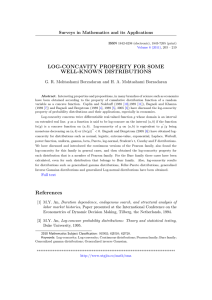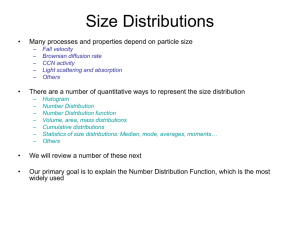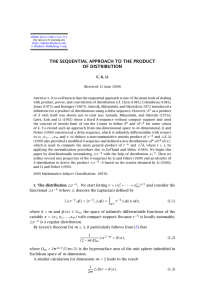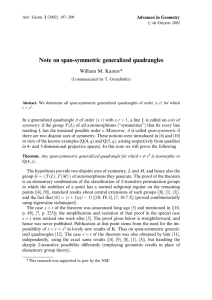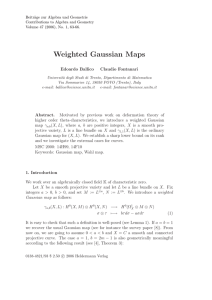LOG-CONCAVITY PROPERTY FOR SOME WELL-KNOWN DISTRIBUTIONS
advertisement
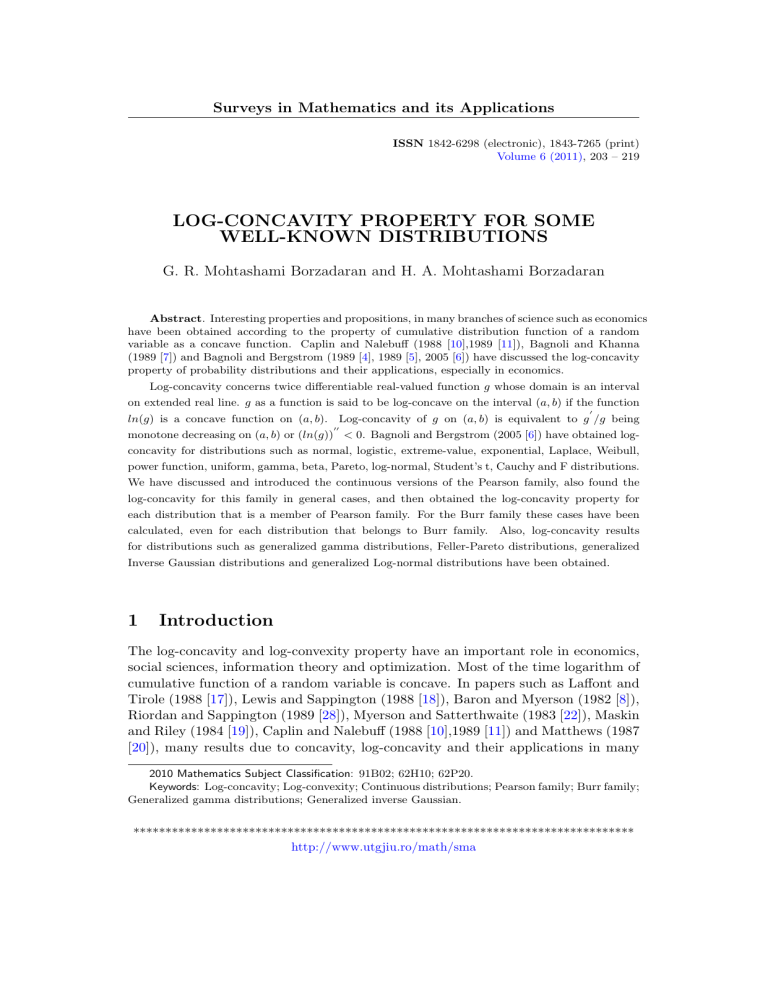
Surveys in Mathematics and its Applications
ISSN 1842-6298 (electronic), 1843-7265 (print)
Volume 6 (2011), 203 – 219
LOG-CONCAVITY PROPERTY FOR SOME
WELL-KNOWN DISTRIBUTIONS
G. R. Mohtashami Borzadaran and H. A. Mohtashami Borzadaran
Abstract. Interesting properties and propositions, in many branches of science such as economics
have been obtained according to the property of cumulative distribution function of a random
variable as a concave function. Caplin and Nalebuff (1988 [10],1989 [11]), Bagnoli and Khanna
(1989 [7]) and Bagnoli and Bergstrom (1989 [4], 1989 [5], 2005 [6]) have discussed the log-concavity
property of probability distributions and their applications, especially in economics.
Log-concavity concerns twice differentiable real-valued function g whose domain is an interval
on extended real line. g as a function is said to be log-concave on the interval (a, b) if the function
0
ln(g) is a concave function on (a, b). Log-concavity of g on (a, b) is equivalent to g /g being
00
monotone decreasing on (a, b) or (ln(g)) < 0. Bagnoli and Bergstrom (2005 [6]) have obtained logconcavity for distributions such as normal, logistic, extreme-value, exponential, Laplace, Weibull,
power function, uniform, gamma, beta, Pareto, log-normal, Student’s t, Cauchy and F distributions.
We have discussed and introduced the continuous versions of the Pearson family, also found the
log-concavity for this family in general cases, and then obtained the log-concavity property for
each distribution that is a member of Pearson family. For the Burr family these cases have been
calculated, even for each distribution that belongs to Burr family. Also, log-concavity results
for distributions such as generalized gamma distributions, Feller-Pareto distributions, generalized
Inverse Gaussian distributions and generalized Log-normal distributions have been obtained.
1
Introduction
The log-concavity and log-convexity property have an important role in economics,
social sciences, information theory and optimization. Most of the time logarithm of
cumulative function of a random variable is concave. In papers such as Laffont and
Tirole (1988 [17]), Lewis and Sappington (1988 [18]), Baron and Myerson (1982 [8]),
Riordan and Sappington (1989 [28]), Myerson and Satterthwaite (1983 [22]), Maskin
and Riley (1984 [19]), Caplin and Nalebuff (1988 [10],1989 [11]) and Matthews (1987
[20]), many results due to concavity, log-concavity and their applications in many
2010 Mathematics Subject Classification: 91B02; 62H10; 62P20.
Keywords: Log-concavity; Log-convexity; Continuous distributions; Pearson family; Burr family;
Generalized gamma distributions; Generalized inverse Gaussian.
******************************************************************************
http://www.utgjiu.ro/math/sma
204
G. R. Mohtashami Borzadaran and H. A. Mohtashami Borzadaran
branches of science such as economics and social sciences have been discussed.
Log-concavity and log-convexity of survival functions are important in reliability
theory that is equivalent to the failure rate being increasing and decreasing respectively.
An (1994) studied classes of log-concave distributions that arise in economics of
uncertainly and information. Bagnoli and Khanna (1989) obtained a model where
there is a distribution reservation demand for houses via log-concavity of reliability
function and similar research by Jegadeesh and Chowdhry (1989 [14]) for studying
the log-concavity of reliability function in finance literature. Let F be the distribution
function, Flinn and Heckman (1983 [12]) stated that if the function
Z ∞
(1 − F (t))dt
H(x) =
x
is log-concave, then with optimal search strategies, an increase in the rate of arrivals
of jobs offers will increase the exit rate from unemployment. Also, Bagnoli and
Bergstorm (1989a) used by the log-concavity of
Z x
G(x) =
F (t)dt
−∞
developed a marring market model.
Fortunately, it happens that sufficient condition for cdf to be log-concave is that
the density function be log-concave. A sufficient condition for the integral of the
cdf being log-concave is that the cdf be log-concave. These results are proved by
Prekopa (1972 [25]) in Hungarian Mathematics Journal. Flinn and Heckman (1983
[12]) introduced these results to the economics literature and were applied by Caplin
and Nalebuff (1988 [10]).
In this paper, based on the theorems and properties mentioned in Bagnoli and
Bergstrom (2005), we have obtained results due to log-concavity for Pearson type,
Burr type distributions and some generalized version of distributions such as generalized
gamma, Feller-Pareto and generalized inverse Gaussian distributions. Also, we have
discussed log-concavity for each members of these families. On noting that, if the
density function f is log-concave on (a, b), then properties of reliability measures
connected to concavity and convexity are discussed.
2
Preliminaries
The concept of log-concavity was revolutionized by introducing log-concave probability
measures due to Prekopa(1971 [24],1973 [26]) and An (1994 [1], 1995 [2], 1997
[3]) completed and reproduced several results on log-concavity from the previous
literature and obtained some new results.
The following definitions and theorems that are discussed here (for more details
see Bagnoli and Bergstrom 2005 [6] that has an important role in our results).
******************************************************************************
Surveys in Mathematics and its Applications 6 (2011), 203 – 219
http://www.utgjiu.ro/math/sma
Log-concavity property
205
Definition 1. A function g is said to be log-concave on interval (a, b) if the function
ln(g) is a concave function on (a, b).
Definition 2. Log-concavity of g on (a, b) is equivalent to each of the following two
conditions:
(i) g 0 /g is monotone decreasing on (a, b).
(ii) (lng)00 < 0.
Lemma 3. Let g be strictly monotonic(increasing or decreasing) defined on the
interval (a, b), it must be that g(x) is also a log-concave function on (a, b).
Let X be continuous random variable with density function f (x) and cdf F (x)
whose support Ω is an open interval such as (a, b) ⊂ <. Define in the interval (a, b),
S(x) ≡ 1 − F (x) as its survivor function,
h(x) ≡ fR(x)/S(x) as its hazard function,
x
G(x) ≡ a F (u)du as its left side integral,
Rb
H(x) ≡ x S(u)du as its right side integral.
Thus, the following notes are needed (See Bagnoli and Bergstrom 2005 [6] and An
1995 [2]), so:
• If the density function f , is monotone decreasing(increasing), then its cdf.,F (S),
and its left side integral, G, are both log-concave.
• (i). If the density function f , is log-concave on (l, h), then the survivor
(reliability) function S, is also log-concave on (l, h).
(ii). If the reliability function S, is log-concave on (l, h), then the right hand
integral H, is log-concave function on (l, h).
• If the density function f , be log-concave on (a, b), then the failure rate is
monotone increasing on (a, b). If the failure rate is monotone increasing on
(a, b), then H 0 /H is monotone decreasing.
• If the density function f is monotone increasing, then the reliability function,
S, is log-concave.
• Among the properties of log-concave distributions, the most surprising result
is that the class of log-concave densities coincides with the class of strongly
unimodal densities.
• Let g : < → <+ be a measurable function. RSuppose {x : g(x) > 0} = (a, b). If
x
g(x) is log-concave on (a, b), then Gl (x) ≡ b g(y)dy is log-concave on (a, b).
For the functions defined above, the following logical implications hold :
f (x) is log-concave ⇒ h(x) is non-decreasing in x,
******************************************************************************
Surveys in Mathematics and its Applications 6 (2011), 203 – 219
http://www.utgjiu.ro/math/sma
206
f (x)
f (x)
f (x)
f (x)
G. R. Mohtashami Borzadaran and H. A. Mohtashami Borzadaran
is
is
is
is
log-concave
log-concave
log-concave
log-concave
⇔ S(x) is log-concave,
⇒ H(x) is log-concave,
⇒ F (x) is log-concave,
⇒ G(x) is log-concave.
Theorem 4. Let X be a random variable whose density function, f (x), is logconcave. Then for any a 6= 0 the random variable Y = αX + β is log-concave.
Proof. See An (1995 [2]).
Theorem 5. Let X be a random variable with monotonically decreasing density
function f (x). Then,
1. If X is Log-concave(log-convex) then, for any α 6= 0, the random variable αX +
β is log-concave(log-convex). In particular, the mirror image, Y = −X, is logconcave(log-convex).
2. If X is log-concave and positive valued then log(X) is log-concave.
3. If X is log-convex, then, eX is log-convex.
Proof. See An (1997 [3]) .
• Let X be a random variable whose density function, f (x), is log-concave and
monotonic decreasing. Consider a function l(.) satisfying:
(i) x = l(y) is strictly increasing, differentiable and convex,
00
(ii) l (y) is log-concave.
Then the random variable Y = l−1 (X) is log-concave.
• The distributions such as uniform, normal, logistic, gamma (G(α, β), α ≥ 1),
beta (B(a, b), a ≥ 1, b ≥ 1) and Weibull (W (γ, α), α ≥ 1) are log-concave
and Pareto, gamma (G(α, β), α < 1), beta (B(a, b), a < 1, b < 1), Weibull
(W (γ, α), α < 1) and F-distribution (F (m1 , m2 ), m1 ≤ 2) are log-convex.
• There are distributions which are both log-concave and log-convex. For example,
the negative exponential distributions are such cases. In fact, since linear
functions are the only functions which are both concave and convex, the only
distributions which are both log-concave and log-convex are exponential or
truncated exponential.
• There are distributions which are neither log-concave nor log-convex over
the entire support. Examples include the log-normal distribution, the Beta
distribution with a > 1 and b < 1 and the F-distribution with the first degree
of freedom m1 > 2.
******************************************************************************
Surveys in Mathematics and its Applications 6 (2011), 203 – 219
http://www.utgjiu.ro/math/sma
207
Log-concavity property
3
Log-concavity of the Pearson and Burr families of
distributions
In this section, via the arguments in Bagnoli and Bergstrom (2005 [6]), the easiest
distributions to deal with that, are the one’s with log-concave or log-convex density
functions where distribution function and failure rate function of them are listed in
Table 1.
The Pearson and Burr families will be introduced before we discuss about logconcavity of the Pearson and Burr families of distributions.
3.1
Pearson family
Pearson (1895 [23]) used as a solution of differential equation
0
f (x)
x−a
,
=
f (x)
b0 + b1 x + b2 x2
(3.1)
where f is the density of the random variable X and it’s derivative exists as the
densities of Pearson family. Also, discrete version of their family is obtained that we
can not use in this discussion. For various values of a, b0 , b1 and b2 , we have some
members of this family that is shown in Table 2.
Theorem 6. For the Pearson family with the form (3.1):
√
a2 b2 2 +b2 (b0 +b1 a)
2
I. If b2 > 0 , a b2 + b0 + b1 a > 0 for x > a +
or x < a −
b2
√
a2 b2 2 +b2 (b0 +b1 a)
, the Pearson family is log-concave.
b2
II. If b2 > 0 , a2 b2 + b0 + b1 a < 0, then√the Pearson family is log-concave.
√
III. If b2 < 0 , a2 b2 +b0 +b1 a < 0 for a−
the Pearson family is log-concave.
a2 b2 2 +b2 (b0 +b1 a)
b2
< x < a+
0
a2 b2 2 +b2 (b0 +b1 a)
,
b2
0
d f (x)
Proof. The Pearson family (3.1) is log-concave if h (x) = dx
( f (x) ) < 0 .
Thus,
x−a
d
0
(
h (x) =
)<0⇒
dx b0 + b1 x + b2 x2
0
h (x) =
−b2 x2 + 2ab2 x + b0 + b1 a
<0⇒
(b0 + b1 x + b2 x2 )2
b2 x2 − 2ab2 x − b0 − b1 a > 0.
(3.2)
(3.3)
(3.4)
So, based on ∆ = 4a2 b22 + 4b2 (b0 + b1 a) and b2 we have these statements for holding
log-concavity property.
******************************************************************************
Surveys in Mathematics and its Applications 6 (2011), 203 – 219
http://www.utgjiu.ro/math/sma
208
G. R. Mohtashami Borzadaran and H. A. Mohtashami Borzadaran
Table 1: Log-concavity of some common Distributions
Distribution
Form of density The derivative of ln f
density
1
Uniform
1
log-concave
x
c.d.f.
log-concave
Reliability
log-concave
x2
− 2
e√
2π
e−x
(1+e−x )2
−x
e−e
−x
log-concave
log-concave
log-concave
e−x −1
e−x +1
log-concave
log-concave
log-concave
e−x
log-concave
log-concave
log-concave
n−2−4x
2x
log-concave
log-concave
log-concave
n+2
2x
log-concave
log-concave
log-concave
−λ
log-concave
log-concave
log-concave
log-concave
log-concave
log-concave
log-concave
log-concave
log-concave
log-concave
log-concave
log-concave
x(a+b−2)−a+1
x(x−1)
log-concave
log-concave
log-concave
e−(lnx) /2
√
x 2π
βx−β−1
− 1+lnx
x
mixed
log-concave
mixed?
− β+1
x
βxβ−1
β+1
x
log-convex
log-convex
log-concave
log-concave
log-convex
mixed
−cxc−1
log-convex
log-concave
log-convex
xm−1 θm e−θx
Γ(m)
− −m+1+θx
x
log-convex
log-concave
log-convex
xa−1 (1−x)b−1
B(a,b)
x(−1)+0.5
x(x−1)
log-convex
mixed?
mixed?
xa−1 (1−x)b−1
B(a,b)
x(.5)−1
x(x−1)
mixed?
mixed?
log-convex
(1−2n)x
n+x2
−2x
1+x2
mixed
mixed?
mixed?
Cauchy
mixed
mixed?
*Denotes answers found, not by analytic means, but by numerical simulation for
particular parameter values see detailed comments on the particular distribution in
Bagnoli and Bergstorm .
mixed?
Normal
Logistic
Extreme Value
n
Chi-Square
Chi
Exponential
Laplace
Weibull(c ≥ 1)
Gamma(m ≥ 1)
Beta
(a ≥ 1, b ≥ 1)
n
x 2 −1 2 2 e−2x
Γ( n
)
2
n
n
x( 2 )−1 e(− 2 ) x2
n
n
2 2 Γ( 2 )
λe−λx
λ −λ|x|
2e
cxc−1 e−x
c
xm−1 θm e−θx
Γ(m)
xa−1 (1−x)b−1
B(a,b)
2
Log Normal
Pareto
Power Function
(β < 1)
Weibull (
(c < 1)
Gamma
(m < 1)
Beta
(a = .5, b = .5)
Beta
(a = 2, b = .5)
cxc−1 e−x
c
x2 −n+1/2
Student’s t
(1+ n )
√
(n)B(.5,n/2)
1
π(1+x2 )
−λ
x≥0
λ
x<0
c−1
−cx
− −m+1+θx
x
******************************************************************************
Surveys in Mathematics and its Applications 6 (2011), 203 – 219
http://www.utgjiu.ro/math/sma
209
Log-concavity property
Table 2: The Pearson Family Distribution
0
Type
Density
Normal
I
exp( −x
2 )
m
1
(1 + x) (1 − x)m2
x∈<
−1 ≤ x ≤ 1
II
III
IV
V
VI
VII
VIII
IX
X
XI
XII
(1 − x2 )m
xm exp(−x)
2
−m
(1 + x )
∗ exp(−υtan−1 (x))
x−m exp(−x−1 )
xm2 (1 + x)−m1
(1 + x2 )−m
(1 + x)−m
(1 + x)m
e−x
x−m
g+x h
( g−x )
−1 ≤ x ≤ 1
x≥0
x∈<
0≤x<∞
0≤x<∞
x∈<
0≤x≤1
0≤x≤1
0≤x<∞
1≤x<∞
−g ≤ x ≤ g
f (x)
f (x)
Support
2
=
x−a
b0 +b1 x+b2 x2
a = b1 = b2 = 0, b0 = −1
m2 −m1
1
, b0 = − m2 +m
, b1 = 0
a = −m
2 +m1
1
1
b2 = m2 +m1
1
1
a = 0, b0 = − 2m
, b1 = 0, b2 = 2m
a = m, b0 = 0, b1 = −1, b2 = 0
ν
1
1
a = − 2m
, b0 = − 2m
, b1 = 0, b2 = − 2m
1
1
a = m , b0 = b1 = 0, b2 = − m
1
2
, b0 = 0, b1 = b2 = m2 −m
a = − m2m−m
1
1
1
a = b1 = 0, b0 = b2 = − 2m
a = m, b0 = b1 = 1, b2 = 0
a = −m, b0 = b1 = 1, b2 = 0
a = b0 = 1, b1 = b2 = 0
a = m, b0 = b2 = 0, b1 = 1
a = −2gh, b0 = g 2 , b1 = 0, b2 = −1
√
√
I. If b2 > 0 , ∆ > 0 then the answer is x < x1 = a− b2∆ , x > x2 = a+ b2∆ (x1 < x2 ).
II. For b2 > 0 , ∆ < 0 it is obvious.
√
√
III. If b2 < 0 , ∆ > 0, then the answer is x1 = a − b2∆ < x < x2 = a + b2∆ .
If we simplify the statements above, it will imply the theorem.
0
On noting that log-concavity of f implies that h(x) =
f (x)
f (x)
should be monotone
0
decreasing on it’s interval, so h (x) < 0.
Remark 7. For Pearson family with the form (3.1) when b2 = 0, then b1 a < b0
implies log-concavity of f . Also, when b1 = b2 = 0, then b0 < 0 implies the logconcavity of f .
According to Theorem 6 we have discussed log-concavity of the Pearson family
in Table 3.
On noting that the normal type of the Pearson family is always log-concave.
******************************************************************************
Surveys in Mathematics and its Applications 6 (2011), 203 – 219
http://www.utgjiu.ro/math/sma
210
G. R. Mohtashami Borzadaran and H. A. Mohtashami Borzadaran
Table 3: Log-concavity for Pearson family
Type
Log-concave
1. m1 m2 > 0
√
√
|m |− |m |
2. m1 m2 < 0 , x > √ 1 √ 2 .
I
|m1 |+
II
III
Type
VII
|m2 |
m>0
m>0
1. m > 0 , x > x2 , x < x1
2. m < 0 , x1 < x < xq
2
−ν± ν 2 +4m2
where x1 , x2 =
2m
2
x< m
√
m2
1. m1 > 0 , m2 > 0 , x < √m −√
m2
1
r 1
2.
m
<
0
,
m
<
0
,
x
>
1
2
m1
−1
m
IV
V
VI
Log-concave
1. m < 0, −1 < x < 1,
2. m > 0, x ∈ (−∞, −1) ∪ (1, ∞)
VIII
IX
m<0
m>0
X
Never
XI
m<0
XII
hgx < 0
2
3.2
Burr family
Burr (1942 [9]) chose to work with cdf F (x) satisfying
dF (x)
= F (x)(1 − F (x))g(x, F (x))
dx
(3.5)
that is the analogue of Pearson system. g(x, F (x)) must be positive forR 0 < F (x) < 1
exp{
x
g(t)dt}
and x in support of x. When g(x, F (x)) = g(x), then F (x) = 1+exp{0R x g(t)dt} that
0
implies 12 distributions as Burr family with various values of g. Table 4 shows cdf
of the random variable X via various values of g:
0
0
0
(x)
Theorem 8. For Burr family with the form (3.5), for the values that ( gg(x)
) < r−e
r,
then the Burr family is log-concave, where r(x) =
rate and reversed hazard rate respectively.
f (x)
F (x)
and re(x) =
f (x)
F (x)
are hazard
Proof. We know that f (x) = F (x)F (x)g(x),
then,
0
f (x)
f (x)
0
=
g (x)
f (x)
f (x)
−
+
F (x) F (x)
g(x)
0
= re(x) − r(x) +
0
So,
d f (x)
dx ( f (x) )
0
0
= (e
r(x)) − r (x) +
g (x)
,
g(x)
(3.6)
0
d g (x)
dx ( g(x) )
< 0, and this implies the theorem.
Remark 9. We can simplify Theorem 8 via special cases of Burr family that is
mentioned in Table 4.
******************************************************************************
Surveys in Mathematics and its Applications 6 (2011), 203 – 219
http://www.utgjiu.ro/math/sma
211
Log-concavity property
Table 4: The Burr Distributions
Type
I
II
III
F (x)
x , 0<x<1
(1 + e−x )−k , x ∈ <
(1 + x−c )−k , x > 0
IV
V
VI
c −k , 0 < x < c
(1 + ( c−x
x ) )
(1 + ce−tanx )−k , − π2 < x < π2
(1 + ce−rsinhx )−k , x ∈ <
VII
2−k (1 + tanhx)k , x ∈ <
1
−1 ex
( 2tanπ
2
c((1+ex )k −1)+2
2
(1 + e−x )k ,
X
(1 +
−kce−rcoshx (1 + ce−rsinhx )−k−1
k(1−tanhx)(1+tanhx)k
2k
−1 x
ke( 2tanπ e )k
sin2πx k
,
2π )
c
−k
− (1 + x )
tan−1 ex (1+e2x2 )
2k ce(1+ex )k
(c((1+ex )k −1)+2)2 (1+ee )
2
k(1 + e−x )k−1 e−2x
, x∈<
x>0
XI
(x −
0<x<1
XII
1
, x>0
4
−
)k , x ∈ <
1−
1
k(1+( c−x
) c )−k−1 ( c−x
)c
x
x
x(x−c)
ce−tanx )−k−1 kc(1 + tan2 x)e−tanx
1
VIII
IX
f (x)
1
ke−x (1 + e−x )−k−1
(1 + x−c )−k−1 kcx−c−1
)k k(1−cos2πx)
(x− sin2πx
2π
x− sin2πx
2π
(1 + xc )−k−1 kcxc−1
Log-concavity for some general version of distributions
In this section, we have discussed log concavity property for some general distributions
including: generalized gamma distributions, Feller-Pareto distributions, generalized
inverse Gaussian distributions and generalized log-normal distributions.
4.1
Generalized Gamma Distributions
The generalized gamma (GG) distribution offers a flexible family in the varieties of
shapes and hazard functions for modeling duration. It was introduced by Stacy (1962
[29]). Difficulties with convergence of algorithms for maximum likelihood estimation
(Hager and Bain, 1970, [13]) inhabited applications of the GG model. Prentice (1974
[27]) resolved the covergence problem using a nonlinear transformation of GG model.
Definition 10. The probability density function of GG distribution, GG(α, τ, λ),
is
fGG (y|α, τ, λ) =
τ
λατ Γ(α)
τ
y ατ −1 e−(y/λ) , y ≥ 0 , α > 0 , τ > 0 , λ > 0,
(4.1)
where Γ(.) is the gamma function, α and τ are shape parameters, and λ is the
scale parameter.
******************************************************************************
Surveys in Mathematics and its Applications 6 (2011), 203 – 219
http://www.utgjiu.ro/math/sma
212
G. R. Mohtashami Borzadaran and H. A. Mohtashami Borzadaran
The GG family is flexible in that it includes several well-known models as subfamilies (see, Johnson et al., 1994 [15]). The sub-families of GG considered here are
exponential GG(1, 1, λ), gamma for GG(α, 1, λ), and Weibull for GG(1, τ, λ). The
log-normal distribution is also obtained as a limiting distribution when α → ∞. By
letting GG(α, 2, λ) we obtain a sub-family of GG which is known as the generalized
normal distribution, GN (2α, λ). The GN itself is a flexible family and includes Halfnormal GG(1/2, τ, λ), Rayleigh GG(1, τ, λ), Maxwell-Boltzmann GG(3/2, τ, λ), and
Chi (GG(k/2, τ, λ), k = 1, 2, ...) distributions.
Theorem 11. The generalized Gamma distribution with the form (4.1) is logconcave
q for
y > λ τ τ1−ατ
(τ −1) .
0
0
(y)
Proof. f is log-concave if ( ff (y)
) < 0 on it’s interval, so :
0
ατ − 1 − τ ( λy )τ + τ 2 ( λy )τ
d f (y)
(
)=−
<0
dy f (y)
y2
q
That implies y > λ τ τ1−ατ
(τ −1) .
Remark 12. For τ = 1, when α ≥ 1, then the special version of the generalized
gamma (gamma distribution) is log-concave.
So, log-concavity of the GG distribution implies the log-concavity of it’s subfamilies such as the generalized normal distribution, gamma, exponential, Weibull
and log-normal distributions on their interval. On noting that the generalized normal
is a flexible distribution and has it’s own sub families such as half-normal, Rayleigh,
Maxwell-Boltzmann and Chi distributions.
4.2
Feller-Pareto distributions
The Feller-Pareto distributions are denoted by GB2(a, b, p, q) and has the pdf
f (x) =
axap−1
, x > 0.
bap B(p, q)[1 + (x/b)a ]p+q
(4.2)
Here all four parameters a,b,p,q are positive, b is a scale and a,p,q are shape parameters.
If the distribution of Y = logX, with density
f (y) =
aeap(y−logb)
, −∞ < y < ∞,
B(p, q)[1 + ea(y−logb) ]p+q
(4.3)
is considered, a turns out to be a scale parameter, whereas p and q are still shape
parameters.
******************************************************************************
Surveys in Mathematics and its Applications 6 (2011), 203 – 219
http://www.utgjiu.ro/math/sma
213
Log-concavity property
Theorem 13. The Feller-Pareto distribution that is defined in (4.2), is log-convex
if ap < 1 and p + q > 4.
Proof. We should prove that
0
−1 + ap − 2( xb )a − ( xb )2 a − qa( xb )a − qa( xb )2 a + a2 ( xb )a p + a2 q( xb )a + ap( xb )a
d f (x)
>0
(
)=
dx f (x)
−x2 (1 + ( xb )a )2
(4.4)
x a
by choosing ( b ) = y, we have
(−aq − 1)y 2 + (ap + a2 q + a2 p − aq − 2)y + ap − 1 < 0.
(4.5)
It implies that,
(a(p − q) + a2 (p + q) − 2)2 < 4(ap − 1)(−1 − aq),
it is necessary that ap < 1.
Also, (4.6) leads to (p + q)((p + q)a2 + 2(p − q)a + (p + q − 4)) < 0
that implies
√
√
q−p+ ∆
q−p− ∆
<a<
where ∆ = 4p + 4q − 4pq.
p+q
p+q
(4.6)
(4.7)
(4.7) is equivalent to (a(p + q) + (p − q))2 < ∆, so, a should be positive, which leads
to p + q > 4.
The special cases of Feller-Pareto size distributions should be log-convex based on
the following conditions :
GB2(a, b, p, 1) ⇒ Dagum distribution is log-convex if ap < 1 and p > 3.
GB2(1, b, p, q) ⇒ Beta distribution of second kind is log-convex when p < 1 and
p + q < 4.
GB2(a, b, 1, q) ⇒ Singh-Maddala distribution is log-convex when a < 1 and
q < 3.
GB2(1, b, 1, q) ⇒ Lomax distribution is always log-convex.
GB2(a, b, 1, 1) ⇒ Fisk(log-logistic) distribution is log-convex for a < 1 and p > 3.
GB2(1, b, p, 1) ⇒ Inverse Lomax distribution is log-convex for 0 < p < 1
Remark 14. A distribution introduced by McDonald an Xu (1995 [21]) as the
”generalized beta” (GB) distribution. The GB is defined by the pdf
GB(x; a, b, c, p, q) =
|a|xap−1 (1 − (1 − c)(x/b)a )q−1
, 0 < xa < ba /(1 − c),
bap B(p, q)(1 + c(x/b)a )p+q
(4.8)
and zero otherwise with 0 ≤ c ≤ 1 and b, p and q positive. As in the ordinary
beta distribution, the parameters p and q control shape and skewness. Parameters
a and b control ”peakedness” and scale, respectively. c = 1 and c = 0 implies the
Feller-Pareto and GB1 distributions.
In general case, finding log-concavity or log-convexity of GB is complicated.
******************************************************************************
Surveys in Mathematics and its Applications 6 (2011), 203 – 219
http://www.utgjiu.ro/math/sma
214
4.3
G. R. Mohtashami Borzadaran and H. A. Mohtashami Borzadaran
Generalized inverse Gaussian distributions
The generalized inverse Gaussian distribution denoted by GIG(µ, c2 , λ), with parameters
(µ, c2 , λ) has the pdf given by
1
x
1 x µ
( )λ−1 exp{− 2 ( + )},
2
2Kλ (1/c )µ µ
2c µ x
0 < x < ∞, −∞ < λ < ∞, 0 < µ < ∞, 0 < c < ∞,
q(x) =
(4.9)
where Kλ (.) denotes the modified Bessel function of the third kind and with index
λ (Kawamura et al. 2003 [16]). In particular, GIG(µ, c2 , −1/2) and GIG(µ, c2 , 1/2)
which are the inverse Gaussian and reciprocal inverse Gaussian distributions respectively.
Also, for GIG(µ, c2 , 0) the Halphen distribution which is a prototype of generalized
inverse Gaussian distribution can be obtained.
Theorem 15. The Generalized Inverse Gaussian with the form (4.9) is log-concave
for the two conditions below:
µ
(i) λ < 1 , x > c2 (1−λ)
µ
(ii) λ > 1 , x < c2 (1−λ)
0
Proof. For the GIG(µ, c2 , λ), we have
simplifying it, we have the theorem.
d f (x)
dx ( f (x) )
2
= − λxc x−xc
3 c2
2 +µ
< 0 and after
Remark 16. when λ = 1 the GIG with the form (4.9) is always log-concave.
The power inverse Gaussian distribution parameterized by an arbitrarily fixed
real number λ 6= 0 denoted by P IGλ (µ, c2 ) has the pdf given by
1
1
x
µ
x
q(x) = p
(( )λ/2 − ( )−(λ/2) )2 },
( )−(1+λ/2) exp{−
2
2(λc) µ
x
(2π)cµ µ
0 < x < ∞ , 0 < µ < ∞ , 0 < c < ∞,
(4.10)
In particular, P IG1 (µ, c2 ) and P IG−1 (µ, c2 ), are the inverse Gaussian and the
reciprocal inverse Gaussian distributions respectively. Also when λ → 0 , the power
inverse Gaussian reduces to a log-normal distribution.
Theorem 17. The Power Inverse Gaussian with the form (4.10) is log-concave for
λ > 1.
Proof. We have,
0
d f (x)
2λc2 + λ2 c2 + (x/µ)λ − (x/µ)−λ − λ(x/µ)−λ − λ(x/µ)λ
(
)=
< 0 (4.11)
dx f (x)
2λc2 x2
where on choosing (x/µ)λ = A, we should prove that
******************************************************************************
Surveys in Mathematics and its Applications 6 (2011), 203 – 219
http://www.utgjiu.ro/math/sma
215
Log-concavity property
Proof.
(1 − λ)A2 + (2λc2 + λ2 c2 )A − (1 + λ) < 0,
(4.12)
Proof. This inequality is true when λ > 1. Note that, when λ < 1, equation (4.12)
is not possible.
For an arbitrarily fixed real numbers λ 6= 0, let a positive random variable X satisfy
the relation
X − µ 1/λ
(1 + λ
)
∼ e(1),
(4.13)
σ
where µ and c are real number with −∞ < x < ∞, 0 < σ < ∞ and e(1) denotes
the exponential distribution with the mean 1. Also the range of X is assumed to
satisfy 1 + λ(X − µ)/σ > 0. We call this distribution of X the generalized Gumbel
distribution GGλ (µ, σ 2 ). The transformation y = (1 + λ(x − µ)/σ)1/λ is one-to-one,
and therefore, the pdf of generalized Gumbel distribution is presented by
Proof.
q(x) =
x − µ (1/λ)−1
x − µ 1/λ
1
(1 + λ
)
exp{−(1 + λ
) }
σ
σ
σ
(4.14)
1 + λ x−µ
σ > 0, −∞ < µ < ∞, 0 < σ < ∞.
Theorem 18. The generalized Gumbel distribution is log-concave based on the
conditions below:
λ
(i). When λ ≤ 1 then, for x ≤ σλ +λµ−σ
generalized Gumbel distribution is logλ
concave.
λ
(ii). When λ > 1 then, for x > σλ +λµ−σ
generalized Gumbel distribution is logλ
concave.
0
Proof. For being log-concave
d f (x)
dx ( f (x) )
< 0. So :
1
0
( σ+λx−λµ
) λ (λ − 1) − λ + λ2
d f (x)
σ
< 0,
(
)=
dx f (x)
(σ + λx − λµ)2
((
σ + λx − λµ 1
) λ + λ)(λ − 1) < 0,
σ
(4.15)
(4.16)
and if we simplify (4.16), we have the theorem.
Remark 19. For σ = λ = µ = 1, the generalized Gumbel distribution is log-convex.
******************************************************************************
Surveys in Mathematics and its Applications 6 (2011), 203 – 219
http://www.utgjiu.ro/math/sma
216
4.4
G. R. Mohtashami Borzadaran and H. A. Mohtashami Borzadaran
Generalized log-normal distributions
Vianelli [31, 32, 33] proposed a three-parameter generalized log-normal distribution.
It is obtained as the distribution of X = eY ; where Y follows a generalized error
distribution, with density
f (y) =
2r1/r σ
1
1
exp{− r |y − µ|r } ,
rσr
r Γ(1 + 1/r)
− ∞ < y < ∞,
(4.17)
where −∞ < µ < ∞ is the location parameter, σr = [E|Y − µ|r ]1/r is the scale
parameter, and r > 0 is the shape parameter. For r = 2 we arrive at the normal
distribution and r = 1 yields to the Laplace distribution. The generalized error
distribution is thus known as both a generalized normal distribution, in particular
in the Italian literature (Vianelli, 1963), as a generalized Laplace distribution. If we
start from (4.17), the density of X = eY is
f (x) =
2xr1/r σ
1
1
exp{− r |logx − µ|r } , 0 < x < ∞,
rσ
r Γ(1 + 1/r)
r
(4.18)
Here eµ is a scale parameter and σr ,r are shape parameters.
Theorem 20. The generalized Error distribution with the form (4.17) is log-concave
for any of these conditions:
(i) y ≥ µ , r > 1 , σr > 0,
(ii) y ≤ µ , r = 2k(k ∈ Z) , r > 1,
(iii) y < µ , r 6= 2k(k ∈ Z) , r < 1 , σr > 0,
(iv) y ≥ µ , r < 1 , σr < 0,
(v) y < µ , r > 1 , σr > 0.
0
Proof. For y ≥ µ and y ≤ µ(r = 2k, k ∈ Z) we have,
1) < 0,
d f (x)
dx ( f (x) )
= −σr−r (y −µ)r−2 (r −
0
d f (x)
and for y ≤ µ(r 6= 2k, k ∈ Z) dx
( f (x) ) = σr−r (y − µ)r−2 (r − 1) < 0.
So, if we simplify them, we have the theorem.
Remark 21. For r = 1 or σr = 0 the generalized error distribution is log-convex.
Remark 22. For generalized log-normal distribution, we can find the log-convexity
properties via Theorem 5 on using log-convexity properties of the generalized error
distribution.
Conclusion 23. In this paper, log-concavity and log-convexity properties for classes
of distributions, such as, Pearson, Burr, generalized gamma, Feller-Pareto distributions,
generalized inverse Gaussian, power inverse Gaussian, generalized Gumbel, generalized
error and generalized log-normal and special cases of them are obtained.
******************************************************************************
Surveys in Mathematics and its Applications 6 (2011), 203 – 219
http://www.utgjiu.ro/math/sma
Log-concavity property
217
Acknowledgement. Partial support from Ordered and Spatial Data Center of
Excellence of Ferdowsi University of Mashhad is acknowledged. Also, the authors
are grateful to the Associate Editor and the referee for suggestions and comments
which have improved the presentation.
References
[1] M.Y. An, Duration dependence, endogenous search, and structural analysis of
labor market histories, Paper presented at the International Conference on the
Econometrics of Dynamic Decision Making, Tilberg, the Netherlands, 1994.
[2] M.Y. An, Log-concave probability distributions: Theory and statistical testing,
Duke University, 1995.
[3] M.Y. An, Log-concavity and statistical inference of linear index modes,
Manuscript, Duke University, 1997.
[4] M. Bagnoli and T. Bergstrom, Courtship as a waiting game, University of
Michigan, Working Paper, 1989.
[5] M. Bagnoli and T. Bergstrom, Signalling and costly appraisals, University of
Michigan, Working Paper, 1989.
[6] M. Bagnoli and T. Bergstrom, Log-concave probability and it’s applications,
Economic Theory, Springer, 26(2)
(2005), 445-469. MR2213177. Zbl
1077.60012.
[7] M. Bagnoli and N. Khanna, Why are buyers represented by sellers agents when
buying a house?, University of Michigan, Working Paper, 1989.
[8] David P. Baron and Roger B. Myerson, Regulating a monopolist with
unknown costs, Econometrica, Econometric Society, 50 (4) (1982), 911-930.
MR0666117(83i:90039). Zbl 0483.90019.
[9] I. W. Burr, Cumulative frequency functions, Annals of Mathematical Statistics,
13 (1942), 215-232. MR0006644(4,19f). Zbl 0060.29602.
[10] A. Caplin and B. Nalebuff, After Hotelling: Existence of equilibrium for an
imperfectly competitive market, Princeton University, Working Paper, 1988.
[11] A. Caplin and B. Nalebuff, Aggregation and social choice: A mean voter
theorem. Princeton University, Working Paper, 1989.
[12] C. Flinn and J. Heckman, Are unemployment and out of the labor force
behaviorally distinct labor force states?, Journal of Labor Economics, 1 (1983),
28-43.
******************************************************************************
Surveys in Mathematics and its Applications 6 (2011), 203 – 219
http://www.utgjiu.ro/math/sma
218
G. R. Mohtashami Borzadaran and H. A. Mohtashami Borzadaran
[13] H. W. Hager and L. J. Bain, Inferential procedures for the generalized gamma
distribution, Journal of the American Statistical Association, 65 (1970), 334342. Zbl 0224.62014.
[14] N. Jegadeesh and B. Chowdhry, Optimal pre-tender offer share acquisition
strategy in takeovers, UCLA Working Paper, 1989.
[15] N. L. Johnson, S. Kotz and N. Balakrishnan, Continuous Univariate
Distributions, vol. 1, 2nd ed. New York:
John Wiley, 1994.
MR1299979(96j:62028). Zbl 0811.62001.
[16] T. Kawamura and K. Iwase, Characterizations of the distributions of power
inverse Gaussian and others based on the entropy maximization principle, J.
Japan Statist. Soc., 33 No. 1 (2003), 95-104. MR2021970(2005b:62032). Zbl
1023.62012.
[17] J. Laffont and J. Tirole, The dynamics of incentive contracts, Econometrica,
56 (1988), 1153-1175. MR0964150(89i:90020). Zbl 0663.90014.
[18] T. Lewis and D. Sappington, Regulating a monopolist with unknown demand,
American Economic Review, 78 (1988), 986-997.
[19] E. Maskin and J. Riley, Monopoly with incomplete information, Rand. Journal
of Economics, 15 (1984), 171-196. MR0755509.
[20] S. Matthews, Comparing auctions for risk-averse buyers: a buyers point of
view, Econometrica, 55 (1987), Issue 3, 633-646. MR0890857(88j:90010). Zbl
0612.90018.
[21] J. B. McDonald and Y. J. Xu, A generalization of the beta distribution with
applications, Journal of Econometrics, 66 (1995), 133-152. Zbl 0813.62011.
[22] R. Myerson and M. Satterthwaite, Efficient mechanisms for bilateral trading,
Journal of Economic Theory, 28 (1983), 265-281. MR0707358(85b:90005). Zbl
0523.90099.
[23] K. Pearson, Contributions to the mathematical theory of evolution, II: Skew
variation in homogeneous material, Philosophical Transactions of the Royal
Society of London ARRAY 186 (1895), 343- 414. JFM 26.0243.03.
[24] A. Prekopa, Logarithmic concave measures with application to stochastic
programming, Acta Scientiarium Mathematicarum, 32 (1971), 301- 315.
MR0315079(47 #3628). Zbl 0235.90044.
[25] A. Prekopa, On the number of vertices of random convex polyhedra, Periodica
Math. Hung., 2 (1972), 259-282. MR0326797(48 #5140). Zbl 0282.60007.
******************************************************************************
Surveys in Mathematics and its Applications 6 (2011), 203 – 219
http://www.utgjiu.ro/math/sma
219
Log-concavity property
[26] A. Prekopa, On logarithmic concave measures and functions, Acta Scientiarium
Mathematicarum, 33 (1973), 335-343. MR0404557(53 #8357). Zbl 0264.90038.
[27] R. L. Prentice, A log-gamma model and its maximum likelihood estimation,
Biometrika, 61 (1974), 539-544. MR0378212(51 #14381). Zbl 0295.62034.
[28] M. Riordan and D. Sappington, Second sourcing, RAND Journal of Economics,
The RAND Corporation, 20 (1) (1989), 41-58.
[29] E.W. Stacy, A generalization of the gamma distribution, The Annals of
Mathematical Statistics, 33 (1962), 1187-1192. MR0143277(26 #836). Zbl
0121.36802.
[30] S. Vianelli, La misura della variabilita condizionata in uno schema generale
delle curve normali di frequenza, Statistica, 23 (1963), 447-474.
[31] S. Vianelli, Sulle curve lognormali di ordine r quali famiglie di distribuzioni di
errori di proporzione, Statistica, 42 (1982), 155-176. MR0685129(84i:62024).
Zbl 0551.62015.
[32] S. Vianelli, Una nota sulle distribuzioni degli errori di proporzione
con particolare riguardo alla distribuzione corrispondente alla prima
legge degli errori additivi di Laplace, Statistica, 42 (1982), 371-380.
MR0695468(84g:62024).
[33] S. Vianelli, The family of normal and lognormal distributions of order r,
Metron, 41 (1983), 3-10. MR0740130. Zbl 0539.62017.
G. R. Mohtashami Borzadaran
H. A. Mohtashami Borzadaran
Department of Statistics,
Department of Statistics,
Faculty of Mathematical Sciences,
Faculty of Mathematical Sciences,
Ferdowsi University of Mashhad,
Ferdowsi University of Mashhad,
Mashhad, Iran.
Mashhad, Iran.
e-mail: grmohtashami@um.ac.ir, gmb1334@yahoo.com
e-mail: hmohtashami66@gmail.com
******************************************************************************
Surveys in Mathematics and its Applications 6 (2011), 203 – 219
http://www.utgjiu.ro/math/sma
